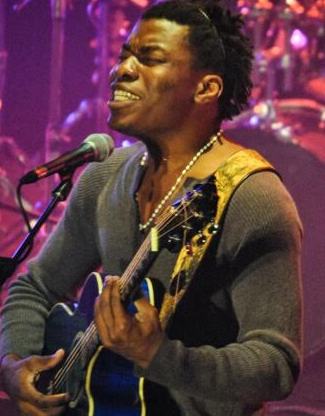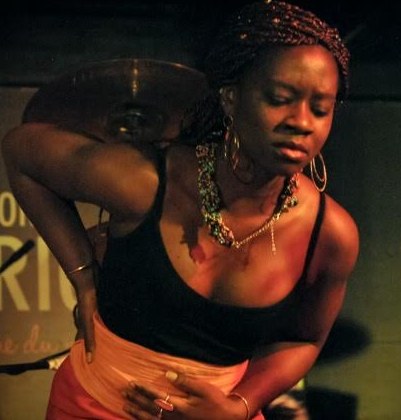Music
was my refuge
I could crawl into the spaces between the notes
and curl my back to loneliness.
Maya Angelou
Affixing
a single concept to the whole of Africa is as laughable (indictable)
as referring to a single American culture – the first
resort of the lazy or uninformed mind. From
its Arabic speaking north, to the formidable Sahara, to the
ample tropical distend southward, to which we add countless
dialects and languages, the whole of which has been woofed and
warped by colonialism (and post-colonialism), Africa is as diverse
as any place on the planet -- a fact which has not been lost
on Montreal’s Nuits
d’Afrique world famous music festival
and its always resourceful programming team led by the resolute
Fréderic Kervadec.
If
there was a common theme or rallying point to this year’s
29th edition, it would be the celebration of diversity that was concentrated in the waves of music that
pulsate from the heart of Africa to the rest of the world through
its diasporic communities, and an acknowledgement that music’s
vast and varied catalogue of genres and sub-genres is not so
much a taxonomy but opportunity.
of diversity that was concentrated in the waves of music that
pulsate from the heart of Africa to the rest of the world through
its diasporic communities, and an acknowledgement that music’s
vast and varied catalogue of genres and sub-genres is not so
much a taxonomy but opportunity.
Hybrid
or fusion music was very much the point of reference for the
group H’Sao, originally from Chad (average January temperature
= 22 Celsuis) but now ‘comfortably’ settled in Montreal
(January = -13 Celsuis). If at first listening it sounds as
if their music hasn’t been affected by 14 consecutive
winters, listen again: their plaintive 4-part harmonies left
no doubt that Chad as home and roots are very much on the minds
of this talented foursome who are belatedly getting the recognition
that is their due. With uncommon facility, they navigate between
gospel-influenced acapella and electric reggae mixed with R
& B.
Among
Latin America’s huge presence, Columbia’s Ondatropica
(tropical wave) was a festival highlight. Their precision-tight
sound consisted of kick-ass, hip-rolling bass lines, catchy
melodies, a horn duo with taste for tectonic dissonance, and
a rhythm section that took its cue from the effects of nitroglycerin.
Wisely, the Fairmount Theatre brain trust removed the tables
and chairs away from the stage, anticipating that no one would
be able to stay put in their seats for very long. Not only the
floor but the entire building was shaking on its girders.
From Germany, the unassuming but much adored Patrice (father
from Sierra Leone) began his set with a succinct sartorial statement
that  was
unambiguously anti-popstar-glitter-and-flash. Think of the Spike
Lee character in Do The Right Thing. Patrice, stealth-like,
arrived at the mike wearing flat white running shoes, skin-coloured
socks, shapeless shorts, a throw away shirt, and in his one
concession to celebrity, a orange tuque which he didn’t
wear over his ears (it was 34 Celsius earlier in the day). “I
don’t want you to look at me but listen to me,”
he implicitly intones in no uncertain terms of endearment.
was
unambiguously anti-popstar-glitter-and-flash. Think of the Spike
Lee character in Do The Right Thing. Patrice, stealth-like,
arrived at the mike wearing flat white running shoes, skin-coloured
socks, shapeless shorts, a throw away shirt, and in his one
concession to celebrity, a orange tuque which he didn’t
wear over his ears (it was 34 Celsius earlier in the day). “I
don’t want you to look at me but listen to me,”
he implicitly intones in no uncertain terms of endearment.
With
the first opening thud of the bass and a sharp rim shot to the
snare, it was instant karma as the audience and singer became
one love. His fans knew what they came for and got more than
what they wanted. Mixing reggae, Genesis-like rock and folk-rock,
Patrice makes the case that while rap and hip-hop rule the charts,
there is no circumventing our innate craving for melody. From
beginning to end his playlist was all about song, and the crowd
joined him on every occasion. It was his first visit to Montreal,
and based on the 1000 leagues deep of love he received, not
only will he be back, he probably end up wintering here.
The
festival's most edifying evening belonged to Sousou and Maher
Cissoko @Club
Balattou and Famalé @Fairmount
Theatre. Cissoko’s kora was contoured
to speak the same language as Nordic pop while Famale’s
kora (played by Zal Sissokho) was stretched to accommodate the
Brazilian interval. There were moments when the spirit of Senegal
combined with the haunting violin of Marcus Viana made mockery
of our preconceptions of what music should be or sound like:
they took the music to a new place, a higher ground and no one
wanted to leave. Both concerts exemplify the dynamism and the
unlimited possibilities of world music for whom all sounds are
valid choices.  We
usually think of the kora as the mood setter, synonymous with
calm and serenity, but in both concerts the instrument was also
played like a lead guitar as the thumb nail attacked the strings
with spirited bite and pinch.
We
usually think of the kora as the mood setter, synonymous with
calm and serenity, but in both concerts the instrument was also
played like a lead guitar as the thumb nail attacked the strings
with spirited bite and pinch.
The
following night, to thunderous applause, Mali-born Awa Sangho
not only brought her incomparable voice to the stage but her
band featured one of the best rhythm sections of the festival:
Mao Otayek on bass and Daniel Moreno: percussion. Conventional
times signatures (6/4, 4/4) were turned on their heads such
that you weren’t  sure
what rhythm you were following except that it felt good and
you wanted more of the same.
sure
what rhythm you were following except that it felt good and
you wanted more of the same.
One
of the festival’s pleasant surprises was the infectious
music of Maya Kamaty, from Ile de la Réunion -- a mere
1000 kms east of Madagascar. She was accompanied by two excellent
guitarists who, like jazz guitarist Lionel Loueke, use classical
strings when they play electric; they also brought first rate
vocal harmonies to a set of music that is infused with the winds
that define the island. Kamaty, who sings mostly in French,
is a songwriter who has absorbed many influences to which she
adds her own highly original, haunting introductions that like
mushrooms after a hot rain burst into melodies that are carried
away on waves of percussive counterpoint. Consistent invention
and engaging dynamic range make her someone to keep an ear out
for.
Great
indoor programming notwithstanding, the real festival doesn’t
begin until it moves to the great outdoors (for the last five
days) to the Quartier des Spectacles where the legendary Timbuktu
market sets up shop and you can feel the grass under your feet
(and in the air) and your nose twitch under the onslaught of
African cuisine at its very authentic best as red hot Cuban
salsa and Senegalese sauces compete with non-stop free music
that begins in the early afternoon until late at night.


For
those of us who mark the passage of our short summers with music,
Les Nuits d’Afrique is much more than the sum of its concerts
and the hundreds of thousands of notes that are played. It is
a cultural event that transcends culture in the sense that it
blesses and rewards what conventional culture abhors: mixing
and exogamy. If we agree that the best and most enlightened
response to adversity is diversity, the Les Nuits d'Afrique
music festival is the inspired messenger and ambassador. Nuits,
in its global outreach, is simply and indisputably the best
there is out there and more: it is the best we can be, and it
is not an accident that it is happening in Montreal. Montrealers
make it happen because the city has become a multi-cultural
hub for attracting not only African musicians but Africans from
all walks of life. Once swept up by the ferment here there is
no looking elsewhere, even in the longest and darkest days of
winter, because when unlike cultures predispose themselves to
rubbing shoulders and sharing the same space, the recombinant
creative possibilities are endless, and we’re all the
richer for it.
All
of which predicts that next year’s special 30th anniversary
will offer more of the same along with what’s baking in
the oven at this very moment – something new and extraordinary.
And for that, 2016 Nuits d’Afrique can’t come soon
enough.
Photos
© Hanna
Donato
Photo #1
© Robert J. Lewis